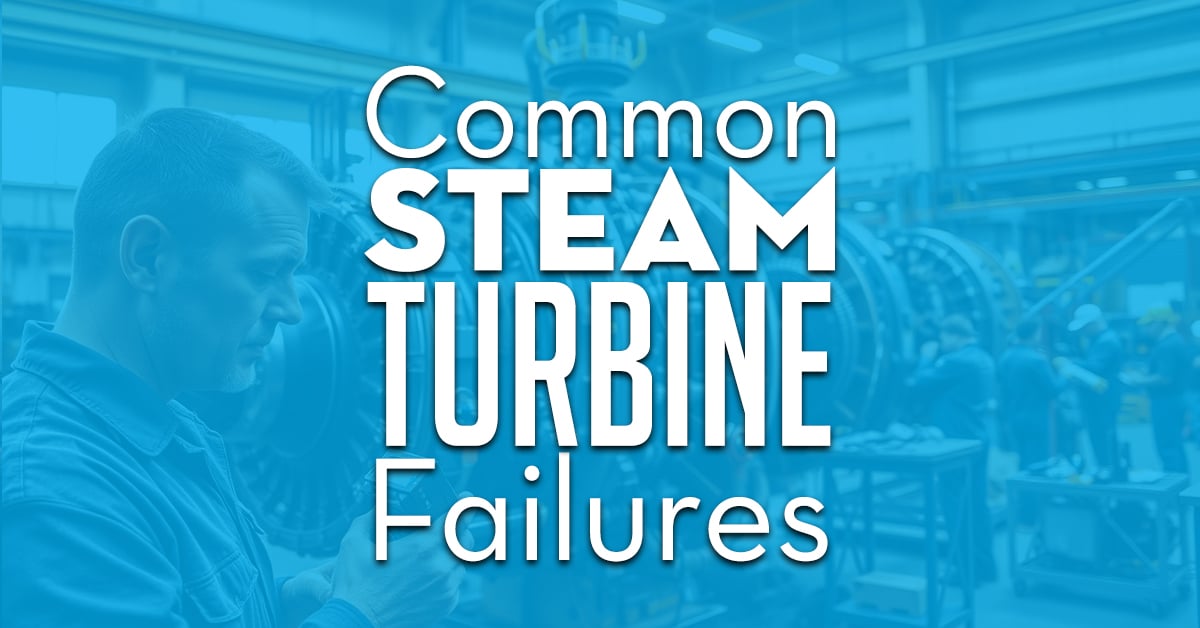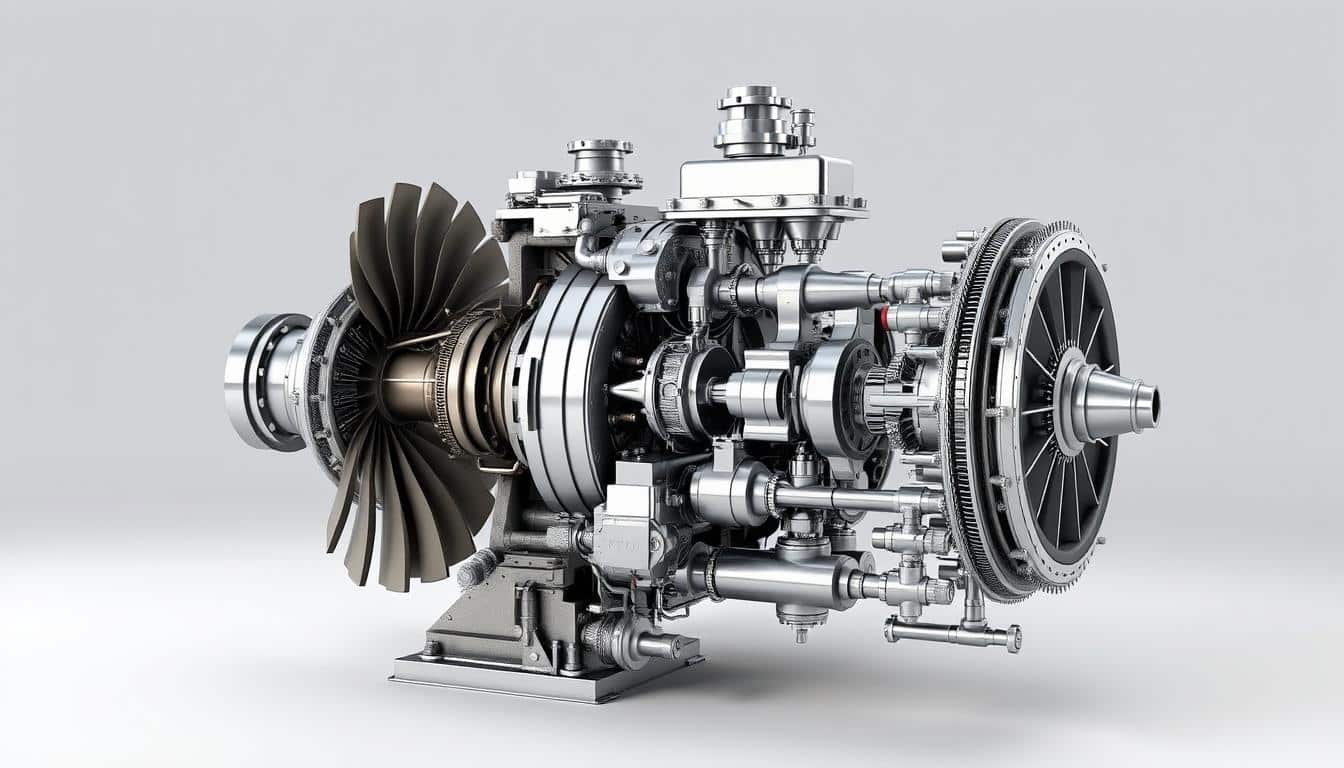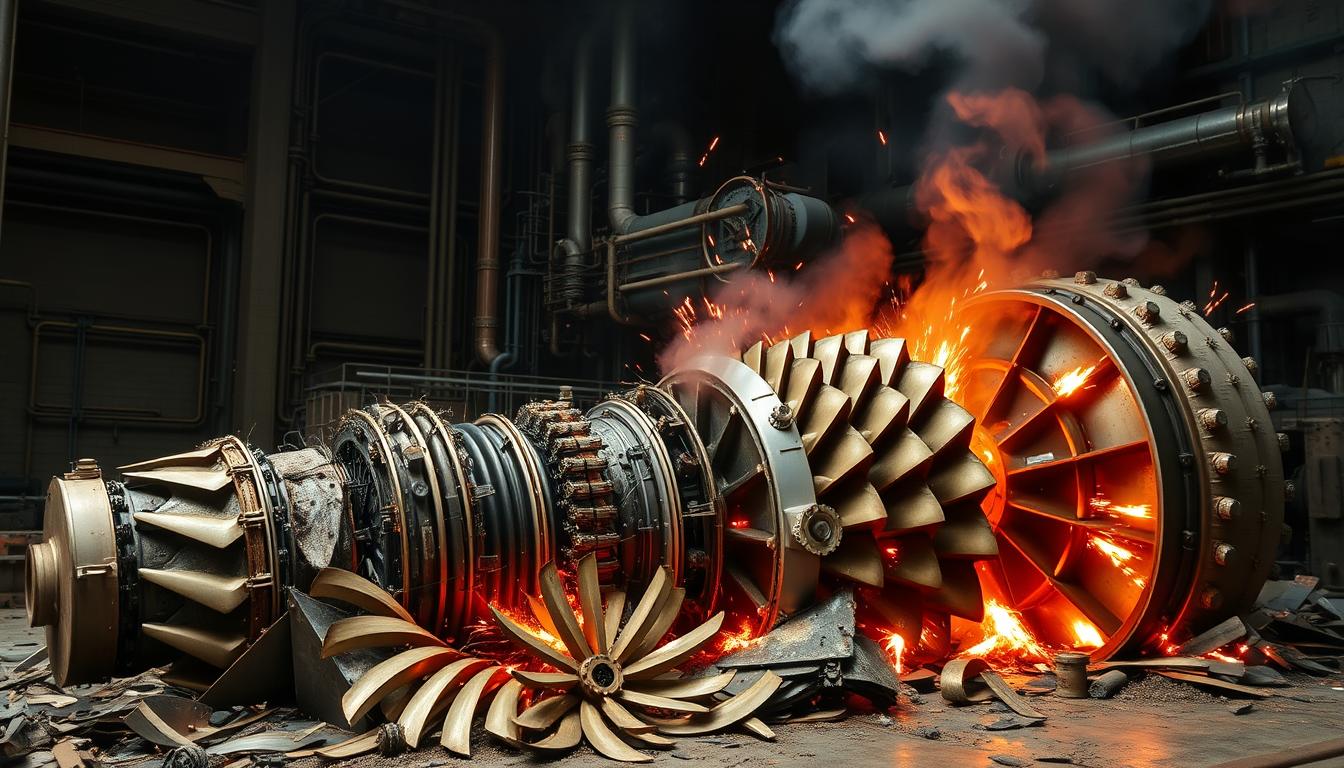Steam turbines are vital in power generation but prone to various failures. These can cause significant downtime and efficiency loss. It’s critical to understand these failures and the role of expert repair services in maintaining turbine performance.
Companies like Allied Power Group in Houston, Texas, are experts in steam turbine repair. They offer services such as diaphragm repair, blade repair, seal repair, weld repair, and nozzle repair. By addressing these issues promptly, power plant operators can avoid more severe damage and ensure their turbines’ reliability.
Key Takeaways
- Common steam turbine failures include diaphragm distortion, structural weld failure, nozzle failures, creep, and seal degradation
- Expert repair techniques can restore flow path integrity, minimize welding distortion, and ensure proper post-weld heat treatment
- Material verification testing is critical before welding to ensure compatibility and prevent further damage
- Proactive maintenance and repair strategies help prevent costly downtime and optimize turbine performance
- Allied Power Group in Houston, Texas, offers specialized steam turbine repair services to address these common failures
Understanding typical failure modes and engaging expert repair services can greatly enhance steam turbine reliability and efficiency. In the following sections, we will explore these failures and the repair techniques used to fix them in more detail.
Understanding Steam Turbine Design and Operation
Steam turbine design is vital for achieving optimal thermodynamic performance and efficiency. The two primary types, impulse turbines and reaction turbines, exhibit unique characteristics and benefits.
Impulse turbines operate by harnessing high-velocity steam jets to propel the rotor blades. In contrast, reaction turbines utilize the pressure drop across the rotor blades to generate power. The selection between these designs hinges on steam conditions, desired efficiency, and maintenance needs.
Key Components: Diaphragms, Blades, and Seals
Several critical components are integral to a steam turbine’s optimal performance. Diaphragms, situated between stages, direct steam flow and ensure proper pressure distribution. Blades, attached to the rotor, convert steam’s kinetic energy into mechanical energy. Seals, along the steam path, minimize leakage, boosting efficiency.
Effective design and upkeep of these components are critical for peak turbine performance. For instance, adherent deposits on turbine blades can distort nozzles, elevate steam resistance, and diminish efficiency and capacity. A 30-MW turbine experienced a 5% loss in generating capacity due to blade fouling from contaminated attemperating water.
| Component | Function | Failure Modes |
|---|---|---|
| Blades | Convert steam energy to mechanical energy | Fatigue, corrosion, pitting, creep |
| Bearings | Support and guide rotor | Abrasion, bond failure, cavitation erosion, corrosion, fatigue, overheating, surface wear, structural damage |
| Rotor | Carries blades and transfers mechanical energy | Thermal, magnetic, dynamic, environmental, mechanical, and residual stresses |
Prevention strategies for these failures include reducing blade stress through enhanced design and materials. Proper lubrication and maintenance can prevent bearing failure. Adhering to speed and mass limits, along with regular maintenance, helps avoid rotor failure.
Typical Steam Turbine Failure Modes
Steam turbines operate under extreme conditions, making them prone to various failure modes. These failures can result in reduced efficiency, unplanned downtime, and costly repairs. It is vital to comprehend the common failure modes to implement effective maintenance strategies and ensure the reliability of steam turbines.
Diaphragm distortion and mechanical damage are prevalent issues in steam turbines. Diaphragms, critical for guiding and controlling steam flow, can distort due to thermal stresses, causing steam path distortion and efficiency reduction. Mechanical damage, such as foreign object impact or improper handling during maintenance, can also compromise diaphragm and other component integrity.
Structural Weld Failure
Structural weld failure is a significant concern in steam turbines. High temperatures and pressures during operation can deteriorate welds over time, leading to cracks and leaks. Factors like fatigue, corrosion, and residual stresses contribute to structural weld failure, which can have severe consequences if not addressed.
Nozzle Failures
Nozzle failures are common in steam turbines. Nozzles direct steam flow onto turbine blades, and damage or blockage can disrupt the steam path, causing vibration and blade resonance. Nozzle failures are often due to erosion, corrosion, or thermal stresses, necessitating regular inspections to identify and address these issues.
Creep and Dishing
Creep and dishing are long-term failure modes resulting from prolonged exposure to high temperatures and stresses. Creep involves gradual deformation of components, while dishing refers to permanent distortion of diaphragms or other flat surfaces. These failures can lead to clearance issues, steam path distortion, and increased vibration, compromising turbine efficiency and reliability.
| Failure Mode | Causes |
|---|---|
| Blade failure | Fatigue, corrosion, pitting, creep |
| Bearing failure | Abrasion, bond failure, cavitation erosion, corrosion, fatigue, overheating, surface wear, structural damage |
| Rotor failure | Thermal, magnetic, dynamic, environmental, mechanical, residual stresses |
| Steam turbine rotor vibration failures | Rotor imbalance, casing misalignment due to temperature fluctuations |
| Blade rubs | Running in the sealing of a high-pressure rotor, leading to bending of the rotor and blade tip rubs |
| Casing misalignment | Misalignment between two shafts of an integrated rotor, leading to eccentricity of the mass center and rotor bending at high rotational speeds |
Understanding typical failure modes and their causes allows steam turbine operators to develop targeted maintenance strategies. Regular inspections, condition monitoring, and timely repairs are essential to prevent failures and extend the life of steam turbine components.
Expert Repair Techniques for Steam Turbine Components
Expert repair techniques are vital for maintaining steam turbines’ reliability and efficiency. These methods focus on specific issues in components like nozzles, sidewalls, diaphragms, and seals. Advanced repair methods and technologies help extend equipment life and reduce downtime.
Nozzle and sidewall damage repair is critical. Nozzle repair involves precision welding and post-weld heat treatment. Sidewall repair tackles cracks and erosion with advanced imaging techniques. These include phased-array ultrasonic testing and X-ray inspection, providing detailed insights for targeted repairs.
Structural Repairs for Welded Diaphragms
Welded diaphragms are a key repair focus. Repairs use specialized weld processes and materials for harsh conditions. Post-weld heat treatment is essential for stability. Experts employ 3D scanning and reverse engineering for precise models and components.
Addressing Mechanically Assembled Diaphragms
Mechanically assembled diaphragms require unique repair approaches. Disassembly, inspection, and reassembly are necessary for proper function. Skilled technicians use specialized tools for seal repair and fastener issues. High-speed balancing facilities validate repaired components for optimal performance.
Seal Repair and Replacement
Effective seal repair and replacement are essential for turbine efficiency. Advanced materials and techniques, like laser cladding, restore seal surfaces. Sometimes, complete replacement is needed for optimal performance. Experts select materials and designs for demanding conditions, reducing frequent repairs.
Expert repair techniques extend steam turbine life, reduce downtime, and optimize performance. Vibration analysis guides repair decisions and maintenance priorities. With the right expertise and technology, even complex repairs can ensure reliable operation for years.
Reliability Centered Maintenance for Steam Turbines
Reliability centered maintenance (RCM) is a cornerstone in asset management for steam turbines. It enables power plants to identify and mitigate risks, ensuring optimal maintenance planning. An RCM program encompasses reactive, preventive, condition-based, and proactive maintenance strategies.
The RCM process is detailed, starting with system selection and data collection. It then defines system boundaries and identifies functions and failures. Next, it conducts a failure mode effect analysis (FMEA) and creates a logic tree diagram. Criticality analysis follows, leading to the selection of maintenance tasks. This structured approach allows for a customized RCM strategy tailored to the specific needs of steam turbines.
Failure Mode Identification and Risk Mitigation
Identifying failure modes is a critical step in RCM for steam turbines. Techniques like FMEA analyze the likelihood and consequences of failures. For instance, phased array ultrasonic testing (PAUT) can detect anomalies as small as 0.020 – 0.030 inches, enabling early crack detection and risk mitigation.
In one case, PAUT revealed a rotor had only 7 years of remaining life, prompting proactive maintenance planning. Another case showed the importance of immediate corrective action after PAUT detected damage, preventing failures. Early identification of failure modes allows for targeted risk mitigation strategies, avoiding costly downtime.
Inspection and Correction Strategies
Effective inspection and correction strategies are vital for maintaining steam turbine reliability. Regular inspections using advanced techniques like PAUT can detect issues before they become major failures. Prompt corrective actions can then be taken to address the problem and prevent further damage.
For example, a client upgraded their rotor with a stainless-steel overlay after PAUT findings revealed corrosion issues, improving corrosion resistance. A well-planned inspection and correction program can significantly reduce downtime costs. A proposed RCM program with spare parts optimization can result in an 80% reduction in downtime costs, saving up to $480,000 per year, and a 22.17% saving on annual spare parts costs.
| Metric | Current | Proposed | Savings |
|---|---|---|---|
| Downtime Cost Rate (per hour) | $10,000 | – | – |
| Total Downtime Cost (per year) | $600,000 | $120,000 | $480,000 (80%) |
| Annual Spare Parts Cost | – | – | 22.17% |
Steam Turbine Failures: A Case Study
A case study of a steam turbine failure at a power plant underlines the critical role of specialized repair solutions. The 1.7 MW steam turbine suffered a blade fracture in the 12th stage after 60,000 hours of service. The fracture occurred in a blade made of X20Cr13 tempered martensitic chrome alloy steel, which showed erosion-corrosion pitting on its leading edge. This pitting initiated and propagated a crack.
Mechanical tests revealed significant alterations in the blade material properties. These included increased hardness and decreased ultimate tensile and yield stress. Yet, chemical and microstructure analyses found no compositional or structural degradation. The initial repair solution involved cutting another blade 180 degrees from the broken one, installing a new guard wire, and performing dynamic balancing.
The root cause analysis uncovered several factors contributing to the steam turbine failure and performance improvement challenges:
- Increased silica levels in steam, exceeding the acceptable limit
- Blade fouling due to steam quality issues and impurities
- Potential issues with boiler feed water quality and blow-down frequency
To tackle these challenges and realize cost savings, the plant undertook several measures:
- Online washing and offline cleaning techniques to remove blade fouling
- Review and enhancement of boiler feed water quality and blow-down frequency
- Monitoring of gland steam condenser pressure to prevent air ingress and maintain turbine vacuum
- Verification of steam seal integrity to minimize steam leakage and moisture ingress into the oil system
By addressing the root causes of the steam turbine failure and implementing targeted repair solutions, the power plant successfully reduced downtime, enhanced turbine performance, and achieved substantial cost savings. This case study highlights the importance of expert repair services in maintaining the reliability and efficiency of steam turbines in industrial settings.
Conclusion: Ensuring Steam Turbine Reliability with Expert Repair Solutions
In today’s power generation landscape, steam turbine reliability is critical. Collaborating with experts like Allied Power Group is essential for managing asset lifecycles and reducing failure risks. Their advanced repair methods, including blade repair, coatings, and design enhancements, enhance turbine efficiency and extend component lifespan.
Implementing proactive maintenance, such as regular inspections and vibration analysis, is vital. This approach helps detect issues early, preventing unexpected downtime. Advanced materials and thorough inspection techniques further boost steam turbine reliability.
Effective repair planning and customer involvement are critical for success. Working with experienced staff ensures quality, schedule adherence, and repair success. This collaboration optimizes steam turbine assets, lowers operational costs, and maintains competitive advantage.
For all your steam turbine repair needs, rely on Allied Power Group for expert solutions. Their focus on reliability, efficiency, and long-term performance makes them the ideal partner. Contact them today to explore their services and how they can support your power generation objectives.
FAQ
What are some common failure modes in steam turbines?
Steam turbines often face issues like diaphragm distortion and mechanical damage, as well as structural weld failure. Nozzle failures and creep and dishing are also prevalent. These problems can cause steam path distortion, blade resonance, and vibration. They also lead to stress risers, which compromise the turbine’s performance and reliability.
How can expert repair services address steam turbine failures?
Expert repair services, like those from Allied Power Group, use advanced methods to fix steam turbine parts. They repair nozzles and sidewalls, and perform structural repairs on welded diaphragms. They also address mechanically assembled diaphragms and replace seals. By choosing the right weld process, materials, and heat treatment, they restore the turbine’s performance and reliability.
What is reliability centered maintenance (RCM) for steam turbines?
Reliability centered maintenance (RCM) is a proactive approach to maintenance for steam turbines. It identifies and mitigates failure modes. RCM uses tools like failure modes and effects analysis (FMEA) and focuses on early detection and correction. It’s vital for asset management and maintenance planning, aiming to optimize power generation assets and reduce failure risks.
How can partnering with expert repair service providers benefit steam turbine operators?
Working with expert repair services, such as Allied Power Group, ensures steam turbine reliability. It offers several advantages, including reduced downtime, improved performance, and cost savings. By adopting proactive maintenance and asset lifecycle management, these services optimize power generation assets. This minimizes failure risks, boosting overall efficiency and profitability.
What are the key components of a steam turbine?
A steam turbine’s key components are diaphragms, blades, seals, and nozzles. These elements are critical for optimizing steam path and thermodynamic performance. Diaphragms guide steam flow, blades extract energy, seals prevent leakage, and nozzles accelerate steam. Proper maintenance and repair of these components are essential for efficient and reliable turbine operation.


